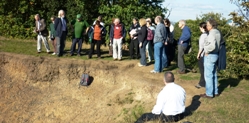 Ian Randall attends the launch of a new initiative to safeguard the capital’s rocky heritage
Ian Randall attends the launch of a new initiative to safeguard the capital’s rocky heritage
Geoscientist Online 20 October 2009
A scheme to help manage and protect London’s geological diversity was launched at Charlton House today. London Foundations, an audit by the London Geodiversity Partnership, has identified 14 sites of regional geological importance and 15 sites of local relevance for preservation.
The launch was opened by Alison Barnes, the regional director of Natural England. ‘It launched us - without the geology and shape of the landscape, and how it has worked for London, we wouldn’t be the city we are today’, she said; London Foundations will help the city ‘start to think about what we need to do to protect [the geology] and celebrate it.’
Natural England’s Jonathan Larwood said that the United Kingdom was one of ‘the most geologically diverse places, for its size, in the world’. Dishing the ‘dirt’ on London’s Foundations, he explained that it would lead conservation: ‘geology is at the top level in these guidelines’, he said, and would form a starting point for development of the plan to ‘[raise] the input of geodiversity in the context of what we value in London’.
Among the locations highlighted by London Foundations were the site of special scientific interest (sssi) Abbey Woods, which contains the highly fossiliferous Lessness shell beds; a dry valley near Carshalton Beeches which was carved out by the actions of permafrost; and the Thames river gravel terrace in Finsbury, Islington.
The building works of London, like St Pauls Cathedral’s Portland stone facade, were noted for their geological diversity. Larwood described the Natural History Museum as ‘such a vast resource of knowledge to be used’. Crystal Palace’s dinosaur park was also cited as a ‘really good way of involving people… in the idea of something that isn’t around anymore.’
With London Foundations having raised awareness of the geodiversity of the capital, the next step for the partnership will be the formation of a geodiversity action plan (GAP) for London. ‘We want it to be at the heart of the city for the future,’ Natural England told
Geoscientist.
The afternoon of the launch hosted a trip to Gilbert’s Pit, one of the geological sites highlighted the audit. The pit, a former quarry whose output was used for glass manufacture and metalworking, forms the most complete in-situ lower Palaeogene section in London. A former Second World War lookout, the pit offers impressive views over the London skyline.
Not much of the outcrop itself is left visible- the chalk base was covered in building rubble at the end of the war, the Thanet sands are buried under talus slopes, and most of the rest of the face is swathed in vegetation. Jackie Skipper, of the Geotechnical Consulting Group, told us of plans to open up the site; it has been proposed to inject calcium carbonate based cement into the face on a rotational system to better reveal the diversity of the different sections of the quarry. ‘It’s important that kids get the opportunity to get their hands on the geology’, she said.
Members of the London Geodiversity Partnership are: Natural England, The Greater London Authority, The British Geological Survey, The London Biodiversity Partnership, The London Borough of Lambeth, The Government Office for London, The South London RIGS Group, Harrow and Hillingdon Geological society and Queen Mary, University of London.